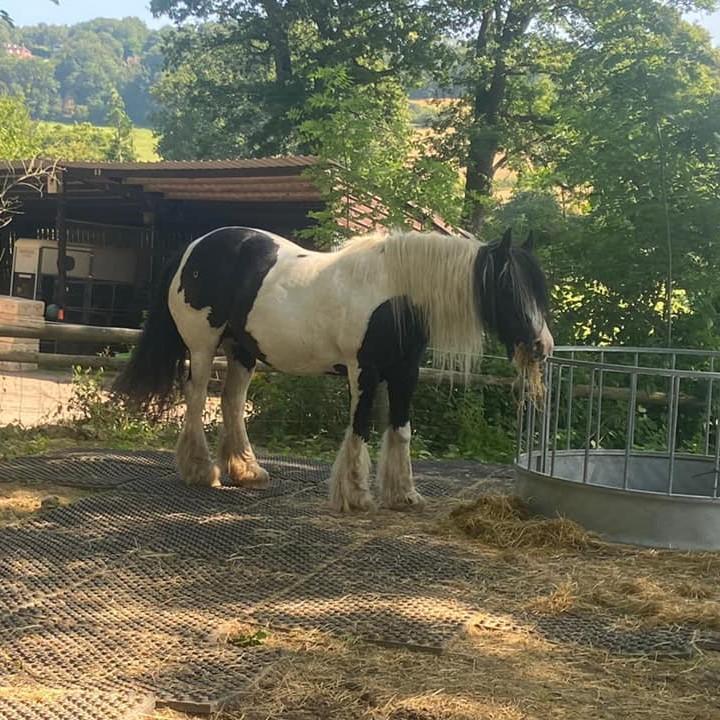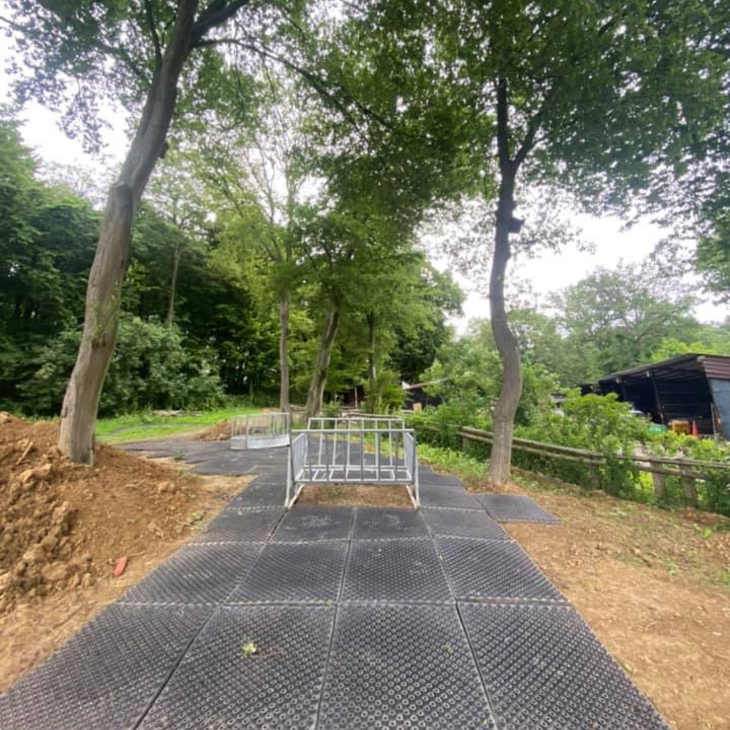How to cope with poor field drainage in wet weather. Why is dry hardstanding important for horses?
Depending on rainfall, soil type and how well the ground drains, most horse owners will find that high footfall areas (such as around gates, feeding areas and water troughs) become wet and muddy very quickly in wet weather and then turnout has to be limited!
This is why a good pasture management programme is especially important when the ground is very wet, otherwise, horse fields can become heavily poached (where the ground is broken into wet muddy patches by the action of the horses’ hooves in the ground) which can lead to difficulties for horse owners and health problems for the horses.
The Department for Environment Food & Affairs states that “in muddy conditions, it is important that a horse has an adequately sized, well-drained area in the pasture on which to stand and lie down, and on which to be fed and watered”. Breaching this Code is not an offence itself, but could be used if proceedings are brought against you for an offence under The Animal Welfare Act 2006. This goes to show just how important it is that we provide our horses with mud-free areas to stand and rest on.
Problems caused by mud?
For some horses, exposure to even modest amounts of mud can cause problems with their hooves and/or skin, such as:
Softening Hooves
Many horses who are waiting to be fed or caught will stand around the gate for long periods of time. If this area is wet or muddy, then the feet do not get a chance to dry out properly. This causes the soles of the hoof to soften, which can be the start of a whole list of other problems, such as bruising or abscesses.
Lost Shoes
Muddy conditions can cause horses to lose shoes more frequently, not because the mud suctions off the shoe, but because the ground is more slippery horses are more likely to step on themselves to re-establish their balance.
Mud Fever
Mud fever is a frustrating ailment seen in horses exposed to wet or muddy environments. It is difficult to treat as it can be caused by viral, bacterial, fungal or parasitic infections.
Tendon and Ligament Damage
In muddy conditions, horses are at risk of twisting their legs unnaturally, which can result in serious (and expensive!) injuries to the delicate tendons and ligaments of the limbs.
Abscesses
Bacteria thrive in moist conditions, so horses standing in mud for long periods of time are at risk of bacteria invading the hoof and working into the sensitive parts of the hoof. It then gets trapped inside the hoof, where it continues to multiply and cause an abscess. Thrush is another common ailment of the hoof which is particularly prevalent over winter, and a speedy healing process requires the horse to have a dry and clean surface to stand on.
Basic tips for dealing with mud
Avoiding prolonged exposure to muddy conditions is the most effective way of reducing the chance of the problems above. Apart from regularly picking out your horse’s feet and drying them with a towel to encourage oxygen into the under-ventilated areas, consider these tips:
- Do not hose the mud off your horse’s legs when he comes in from the field. Although this seems counter-intuitive, recent research suggests this makes mud fever more difficult to fight. This is because the horse’s limbs become cold which restricts blood flow and the number of antibodies travelling to the lower limbs to fight the mud fever. If you do wash your horse’s legs, use warm water and then make sure to keep them walking until they are dry.
- Remove horses when the ground is very wet to rest the paddocks and give the hooves a chance to dry out. If possible, designate a field for winter turnout; ideally use the paddock with the best drainage over the colder and wetter months.
- Regularly clean out field shelters to keep the bedding as dry as possible.
- Ground mats or ‘mud mats’ are commonly used by horse owners to create effective hardstanding. We have found HIT Top Clean mats to be favoured by many horse owners, as they are specifically designed for horses, both barefoot and shod, to create slip-free and hard-standing areas.
TEAL CIC uses Jelka HIT Top Clean mats to transform wet weather management
Surrey-based, award-winning equine therapeutic centre, TEAL CIC, has found the Top Clean mats to be “a total lifesaver over the winter as the horses have had a mud-free area to eat their hay from and nice mud-free pathways to get between the fields and open barn”.
Click here to see how our other clients keep their horses safe with Top Clean ground mats…
At Jelka we specialise in creating equine facilities that optimise safety and performance for horses and owners. Please contact us for further advice.


